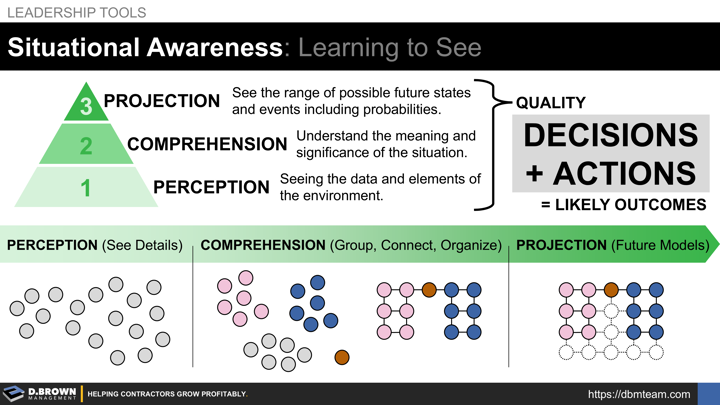The three ascending levels of Situational Awareness as defined by Dr. Mica Endsley who served as the Chief Scientist of the U.S. Air Force:
- Perception: Seeing the data and elements of the environment. (Seeing the Details)
- Comprehension: Understanding the meaning and significance of the situation. (Grouping, Connecting, Discarding, Organizing)
- Projection: Seeing the range of possible future states and events including probabilities. (Future Models)
Each of these levels is foundational, so weaknesses in one layer will dramatically impact the quality of the next layer. Capabilities within each layer can be evaluated, developed, and enhanced through the use of tools. We will provide some examples below.
Perception (Seeing the Details)
The best examples in construction are at the project level, starting with the contract documents and including plans, specifications, and scopes, along with related building codes. Examples below can be used for training, development, and evaluation of someone's competency level. They are very tangible things that can either be set up as exercises against a model where the correct results are known, or as a "double do," where an experienced person with demonstrated capabilities does the task separately from the person who is being trained or evaluated. In either case, the results are compared, and feedback is provided.
- Building a submittal log that identifies every deliverable required, from initial submittals or shop drawings through warranties, training, spare parts, and the O&M manuals, ensures comprehensive project tracking. Breaking out every detail from the various schedules on the plans and specific sections of the specs demonstrates conscientiousness and attention to detail.
- Walking a project to identify punch list items (details) and areas of concern (safety, quality, productivity) is a great way to evaluate and train foremen, superintendents, and project managers.
- Building a material list for an area on the project based on the plans and specifications.
It is amazing to see the extremely wide variations between how thoroughly people perform any of the above–even for those with the same years of experience. It is just as amazing to see how quickly those gaps can be closed with intentional management and coaching. As an example, in some of our field productivity workshops we will have people build a material and tool list for an area of work. There is often a 2-3X difference in the length of the lists as well as the accuracy, and that is in a controlled environment. Think about how that impacts the ability to do Short-Interval-Planning (SIP) and ensure the crews are productive each day, given that material and tools are two of the six pillars of productivity.
You can make significant progress just by training yourself and your team to "see waste," and the best resource we've found for that is 2-Second Lean by Paul Akers.
Comprehension (Grouping, Connecting, Discarding, Organizing)
Some similar examples in construction include:
- Identifying conflicts between drawings, specifications, scopes, and building codes. This can start with the basics like comparing a couple plan sheets and be supported by tools including checklists.
- Identifying gaps in drawings, specifications, and scopes. This is more difficult and requires contextual knowledge of how a whole project goes together in detail to compare the construction documents against.
- Identifying changes between project schedules.
Chapter 8 of Smarter Faster Better describes why information clarity can often negatively impact comprehension. This is counterintuitive but very important to understand as you design scoreboards and scorecards and integrate them with technology.
Projection (Future State Models)
This final layer builds upon the strength of the two underlying layers. If you don't see the right details (perception), there is no way to comprehend effectively. If you don't have the appropriate context and experience to comprehend, there is no way to have an accurate future projection. This future projection includes multiple models of how the future could play out based on different decisions made and actions taken.
- Given some basic schematic drawings, a great conceptual estimator can build an extremely detailed cost model with a range of input variables that will help inform decision making by the project owner. This level of preconstruction provides an extreme competitive advantage.
- Based upon a job walk (perception) and understanding of the construction documents (comprehension), developing a completion plan including timing, crew, and costs along with risks.
- Moving above the project level, building a business model based on strategic decisions and how you expect them to play out over the next 5-10 years.
Note that in more complex environments like running a contracting business, future outcomes are typically a range of possibilities that must be weighted for probability in order to make the best possible decisions.
On the foundation of situational awareness comes decision and action, which feeds back into the loop. Learn more about the OODA (Observe, Orient, Decide, and Act) Loop and the PDCA (Plan, Do, Check, Act) Cycle.

